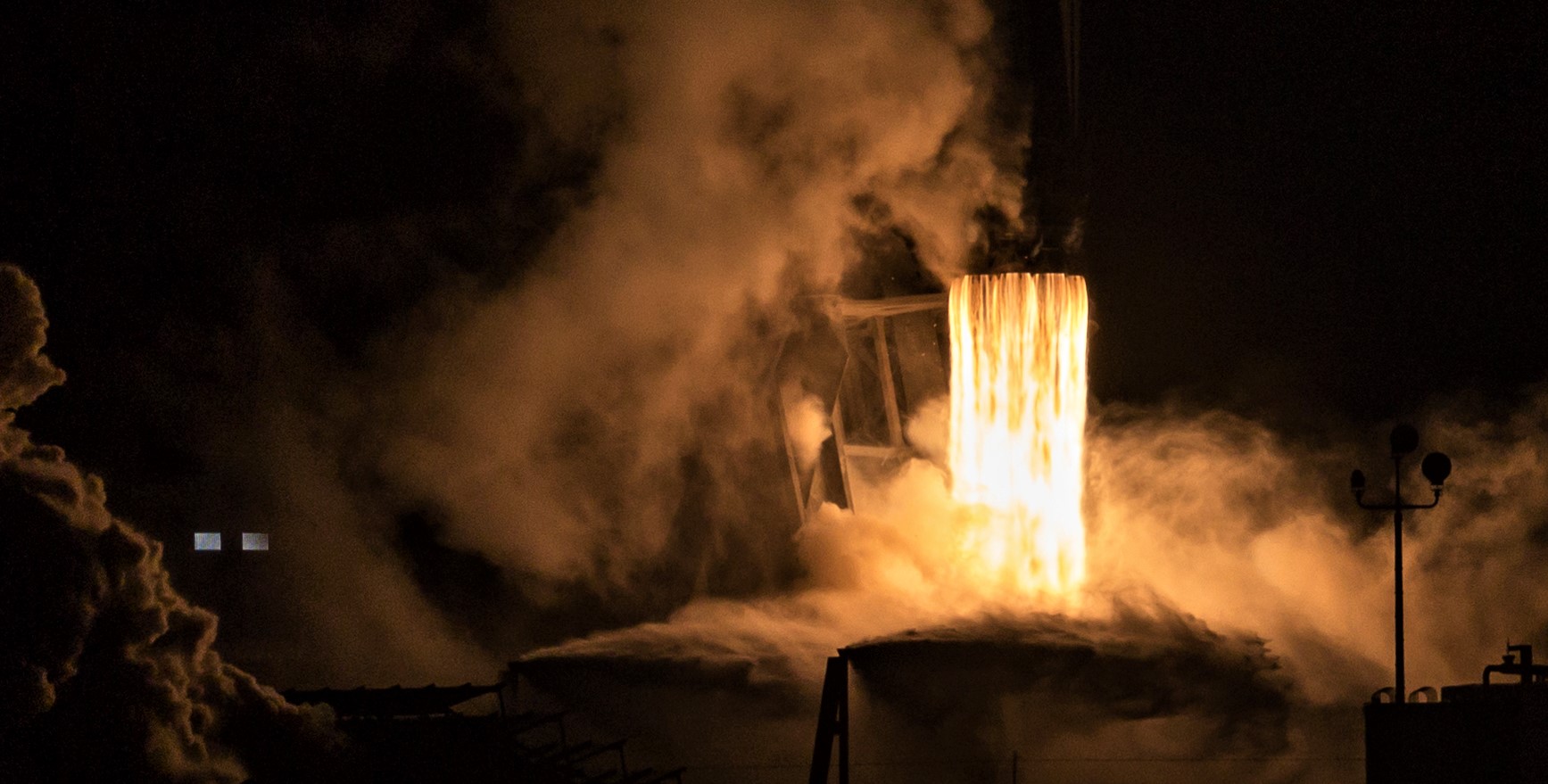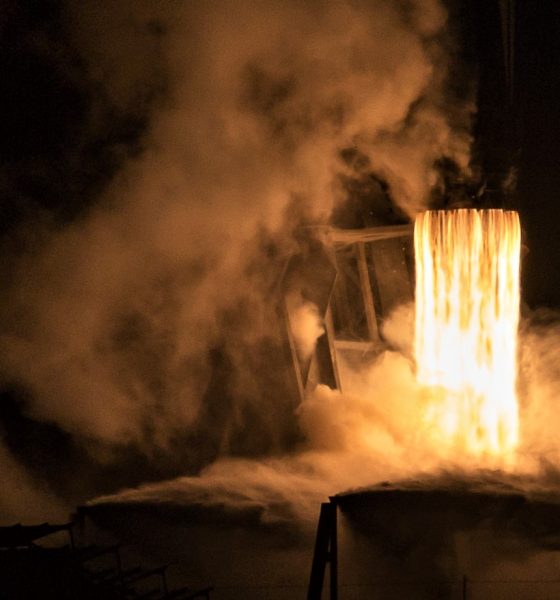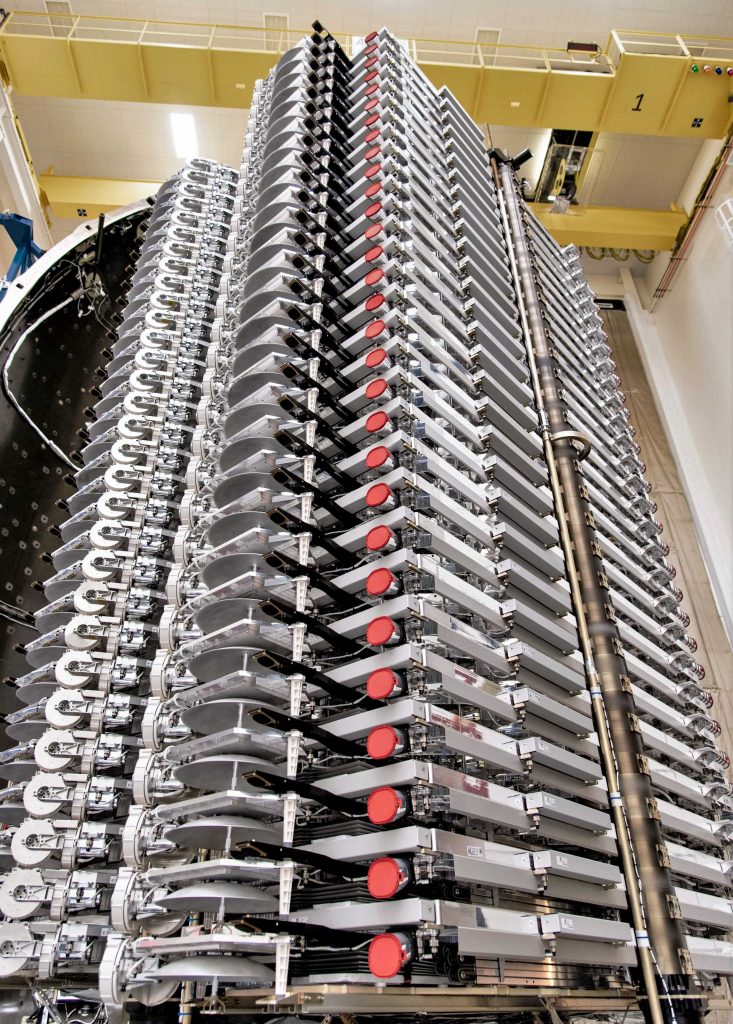

News
SpaceX Falcon 9 rocket tests engines for first launch and landing of the new decade
SpaceX has successfully fired up a Falcon 9 rocket for the first time in 2020, setting the company up for the first of potentially dozens of Starlink launches over the next 12 months.
On the afternoon of January 4th, SpaceX loaded Falcon 9 with hundreds of tons of liquid oxygen, refined kerosene (RP-1), nitrogen, and helium and ultimately ignited all nine of the booster’s Merlin 1D engines, briefly producing some 7600 kN (1.7 million lbf) of thrust in a routine test known as a wet dress rehearsal (WDR) and static fire. As is tradition, SpaceX confirmed that the test looked successful just a handful of minutes after it was completed and verified that the rocket is now scheduled to launch 60 new Starlink satellites as early as 9:19 pm ET, January 6th (02:19 UTC, Jan 7).
Set to lift off from its LC-40 Cape Canaveral Air Force Station (CCAFS) launch pad, SpaceX’s first launch of the new year and decade hints at what is expected to follow over the course of 2020. In simple terms, the company’s ambitions have never been higher and anywhere from 36 to 38 orbital launches are scheduled between now and 2021 – some 65% of which will likely be internal Starlink missions.
If SpaceX manages to launch even half as many Starlink missions as it says it wants to this year, the company will be heading into 2021 with an operational internet satellite constellation nearly a thousand spacecraft strong – almost enough to ensure uninterrupted global coverage. Already, if SpaceX’s January 6th launch – known as Starlink V1 L2 (the second launch of v1.0 satellites) – goes as planned, the company will almost certainly become the owner of the world’s largest commercial satellite constellation less than eight months after it began launching its unique flat-packed spacecraft.

In a classic SpaceX move, the company’s Starlink satellite bus is a radical departure from all other commercial spacecraft, opting for a table-like rectangular shape that is extremely flat. While the rectangular shape – likely chosen for the extreme ease of manufacturing it should allow – significantly decreases packing efficiency, Starlink’s flat design and unique deployment mechanism means that SpaceX can fit an unprecedented 60 satellites (each weighing more than 250 kg or 550 lb) into a single lightly-modified Falcon 9 payload fairing.
Ultimately, SpaceX also design its Starlink satellites to be dramatically more robust than any comparable commercial spacecraft, meaning that they are meant to tolerate the violent acoustic launch environment without foam sound suppression panels that otherwise take up space inside Falcon 9’s fairing. Additionally, they are meant to survive the odd collision during their bizarre deployment, in which Falcon 9’s upper stage spins itself like a fan and releases the entire 60-satellite stack at once. Further, this means that Starlink satellites can be transported from their Washington state factory to Cape Canaveral, Florida far more easily and cheaply than almost any other spacecraft of a similar size and weight.
Falcon 9’s second fourth flight
It’s a mouthful, but SpaceX’s Starlink-2 mission will technically mark Falcon 9’s second fourth flight, meaning that it will be the second time a single Falcon 9 booster launches (and optimally lands) for the fourth time. Thrice-flown Falcon 9 booster B1049 has been assigned to support the launch.
The fourth completed Falcon 9 Block 5 booster, B1049 debuted on September 10th, 2018 on the Telstar 18V satellite launch, followed by a second flight (Iridium-8) in January 2019 and its third and most recent launch in May 2019. B1049’s most recent mission happened to be the very first dedicated Starlink launch, placing 60 Starlink v0.9 spacecraft in orbit in a sort of massive beta test of SpaceX’s cutting-edge satellite technology and design.
In support of Starlink V1 L1, the first launch of finalized Starlink v1.0 satellites, Falcon 9 booster B1048 became the first SpaceX rocket to successfully launch and land four times in November 2019, safely returning to shore aboard drone ship Of Course I Still Love You (OCISLY) a few days later. With (hopefully) two (and soon three) recovered boosters with four flights each under their belts, SpaceX will have a relative wealth of data it can then use to plot the way forward to fifth flights of boosters and beyond – halfway to the minimum Block 5 design goal of 10 launches apiece.
Teslarati photographer Richard Angle (@RDanglePhoto) will be on-site to capture SpaceX’s first Falcon 9 launch and booster recovery of the 2020s. Stay tuned for more details and photos as the launch nears!
Check out Teslarati’s Marketplace! We offer Tesla accessories, including for the Tesla Cybertruck and Tesla Model 3.

Investor's Corner
Tesla gets price target bump, citing growing lead in self-driving

Tesla (NASDAQ: TSLA) stock received a price target update from Pierre Ferragu of Wall Street firm New Street Research, citing the company’s growing lead in self-driving and autonomy.
On Tuesday, Ferragu bumped his price target from $520 to $600, stating that the consensus from the Consumer Electronics Show in Las Vegas was that Tesla’s lead in autonomy has been sustained, is growing, and sits at a multiple-year lead over its competitors.
CES 2026 validates Tesla’s FSD strategy, but there’s a big lag for rivals: analyst
“The signal from Vegas is loud and clear,” the analyst writes. “The industry isn’t catching up to Tesla; it is actively validating Tesla’s strategy…just with a 12-year lag.”
The note shows that the company’s prowess in vehicle autonomy is being solidified by lagging competitors that claim to have the best method. The only problem is that Tesla’s Vision-based approach, which it adopted back in 2022 with the Model 3 and Model Y initially, has been proven to be more effective than competitors’ approach, which utilizes other technology, such as LiDAR and sensors.
Currently, Tesla shares are sitting at around $433, as the company’s stock price closed at $432.96 on Tuesday afternoon.
Ferragu’s consensus on Tesla shares echoes that of other Wall Street analysts who are bullish on the company’s stock and position within the AI, autonomy, and robotics sector.
Dan Ives of Wedbush wrote in a note in mid-December that he anticipates Tesla having a massive 2026, and could reach a $3 trillion valuation this year, especially with the “AI chapter” taking hold of the narrative at the company.
Ives also said that the big step in the right direction for Tesla will be initiating production of the Cybercab, as well as expanding on the Robotaxi program through the next 12 months:
“…as full-scale volume production begins with the autonomous and robotics roadmap…The company has started to test the all-important Cybercab in Austin over the past few weeks, which is an incremental step towards launching in 2026 with important volume production of Cybercabs starting in April/May, which remains the golden goose in unlocking TSLA’s AI valuation.”
Tesla analyst breaks down delivery report: ‘A step in the right direction’
Tesla has transitioned from an automaker to a full-fledged AI company, and its Robotaxi and Cybercab programs, fueled by the Full Self-Driving suite, are leading the charge moving forward. In 2026, there are major goals the company has outlined. The first is removing Safety Drivers from vehicles in Austin, Texas, one of the areas where it operates a ride-hailing service within the U.S.
Ultimately, Tesla will aim to launch a Level 5 autonomy suite to the public in the coming years.
Elon Musk
Elon Musk’s Biggest Revelations on AI, Robots, and the Future of Work from the Moonshots Podcast

Elon Musk’s appearance on the Moonshots with Peter Diamandis podcast was packed with bold predictions, candid admissions, and surprising tech insights. The nearly three-hour conversation covered everything from artificial intelligence to humanoid robots, geopolitics, and the future of work. Here are the top 10 most intriguing takeaways:
-
Aggressive AGI Timeline Predictions
Musk offered a detailed view on when artificial general intelligence (AGI) could emerge, suggesting it may arrive sooner than many expect, emphasizing both transformative potential and risks.
-
U.S. vs. China in the AI Race
He discussed the strategic competition between the United States and China over AI development, noting that geopolitical dynamics will shape how and who leads in the next decades.
-
Future of Job Markets
Musk touched on how AI and automation could reshape employment, predicting massive boosts in productivity alongside potential disruptions in traditional work structures.
-
Clean Energy Transition
A recurring theme was the role of clean energy in future economies, with Musk reiterating the importance of scaling sustainable power generation and storage.
-
Humanoid Robots Are Coming
On the podcast, Musk elaborated on Tesla’s work on humanoid robots, hinting at timelines and applications that go beyond factories to general-purpose assistance.
-
Tesla Roadster “Last Human-Driven Car”
Outside the core discussion topics, Musk teased features of the upcoming Tesla Roadster — calling it “the best of the last of the human-driven cars” and suggesting safety won’t be its main selling point.
-
The Role of AI in Clean Energy and Robotics
Linking AI to both energy optimization and robotics, Musk explained how smarter systems could accelerate decarbonization and task automation across industries.
-
U.S. Innovation Leadership
Musk argued that maintaining American leadership in key tech sectors like AI, space, and robotics should be a national priority, with thoughtful policy and investment.
-
Job Creation vs. Job Elimination
While acknowledging automation’s disruptive effects, he also outlined scenarios where new industries and opportunities could emerge, particularly in AI, space, and advanced manufacturing.
-
Long-Term Vision for Humanity
Throughout the conversation, Musk revisited his long-term philosophical views — including a belief in humanity’s responsibility to become a multi-planetary and technologically empowered species.
Whether you agree with Musk’s optimism or not, the podcast offers a window into the thinking of one of the most influential figures in tech today, in and why his visions continue to spark debate and inspiration.
Elon Musk
Elon Musk just said some crazy stuff about the Tesla Roadster

Elon Musk appeared on the Moonshots podcast with Peter Diamandis today to discuss AGI, U.S. vs. China, Tesla, and some other interesting topics, but there was some discussion about the upcoming unveiling of the Roadster, the company’s electric supercar that will arrive several years after it was initially slated for release.
Musk made some pretty amazing claims about the Roadster; we already know it is supposed to be lightning-fast and could even hover, if Tesla gets everything to happen the way it wants to. However, the car has some pretty crazy capabilities, some of which have not even been revealed.
On the podcast, Musk said:
“This is not a…safety is not the main goal. If you buy a Ferrari, safety is not the number one goal. I say, if safety is your number one goal, do not buy the Roadster…We’ll aspire not to kill anyone in this car. It’ll be the best of the last of the human-driven cars. The best of the last.”
🚨 Elon on the Roadster unveiling, scheduled for April 1:
— TESLARATI (@Teslarati) January 6, 2026
Musk makes a good point: people who buy expensive sports cars with ridiculous top speeds and acceleration rates do not buy them to be safe. They hope they are safe in case of an emergency or crash, but safety is not at the forefront of their thoughts, because nobody buys a car thinking they’ll crash it.
The Roadster is truly going to push the limits and capabilities of passenger vehicles; there’s no doubt about that. Tesla plans to show off the new version car for the first time on April 1, and Musk has only hinted at what is possible with it.
Musk said back in November:
“Whether it’s good or bad, it will be unforgettable. My friend Peter Thiel once reflected that the future was supposed to have flying cars, but we don’t have flying cars. I think if Peter wants a flying car, he should be able to buy one…I think it has a shot at being the most memorable product unveiling ever. [It will be unveiled] hopefully before the end of the year. You know, we need to make sure that it works. This is some crazy technology in this car. Let’s just put it this way: if you took all the James Bond cars and combined them, it’s crazier than that.”
Production is set to begin between 12 and 18 months after the unveiling, which would put the car out sometime in 2027. Hopefully, Tesla is able to stay on track with the scheduling of the Roadster; many people have been waiting a long time for it.








